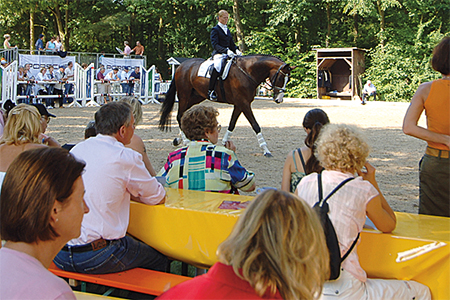 It is simply the world’s most exciting Young Horse Show, and a mecca for breeders from all over the world who come to get a feel for state-of-the art breeding. Five days of breeders’ heaven. Like Topsy, the German National Championships for Young Horses has just grown and grown, the more so when it stopped wandering around from venue to venue, and settled into its ‘home’ in Warendorf, in the grounds of the German Olympic Training centre (DOKR). The first Bundeschampionate was held in 1976 in Münster but it has been in Warendorf since 1994.
It is simply the world’s most exciting Young Horse Show, and a mecca for breeders from all over the world who come to get a feel for state-of-the art breeding. Five days of breeders’ heaven. Like Topsy, the German National Championships for Young Horses has just grown and grown, the more so when it stopped wandering around from venue to venue, and settled into its ‘home’ in Warendorf, in the grounds of the German Olympic Training centre (DOKR). The first Bundeschampionate was held in 1976 in Münster but it has been in Warendorf since 1994.
No one is better qualified to introduce Germany’s show of shows for young horses – the Bundeschampionate – than Susanne Miesner. Susanne has won and placed many times at the show, and also plays a key role in the development of the classes, and the tests that are used. Like me, Susanne loves the show, but like me, can see worrying elements in the format and the increasing fixation on winning at the Bundeschampionate as an end rather than a young horse evaluation on the way to a mature sport horse career…
“Warendorf is the perfect place to hold these championships – and that is what the Bundeschampionate means – ‘national championships’ – the show that sets out to identify the best young horses in Germany. Even after the opening of the Wall, Warendorf is still kind of the centre of Germany. From many areas it is about the same distance to go. And that is why we have such a phenomenal number of spectators…”
“In my opinion, the DOKR is just a fantastic place to run the show. It is an area where you can move around from one feature to another, from the dressage arena, past the eventing horses and you hear all the screaming, past the driving horses, the pony riders in the woods, the huge crowds in the jumping arena, it’s really amazing that with the exception of vaulting, all the other disciplines are in this one area, enclosed in these beautiful woods.”
“Back in 1994 the Championships moved to Warendorf, and that works really well because everyone has been here before. It’s the same parking guys for the last 13 years, the same girl sells the tickets, the beer stands are at the same spot. Everybody who goes there feels at home, there’s never something new – the only new things are the horses and the judging of the horses.”
“For the young horses we have the suitability classes. In America, they say, suitability to become a dressage horse. In Germany, it’s Reitpferde Prüfung and that should just mean a good riding horse, but in essence, you will see we are looking for a dressage horse. I think we should rename the class to suitability to become a dressage horse – because that is what we are looking for. We have three-year-old suitability classes, with one class for geldings and mares, and one class for the stallions.”
“To qualify is difficult. We have 17 breeding regions in Germany and each of the regions has its own breeding society: for example – Hanover, Westfalia, Holstein – and they do their own pre-selection, and how many they are allowed to send, depends on the number of breeding mares they have. Hanover is the biggest, and they can send 12 horses in the 3 and 4-year-old classes. So they could, if they liked send ten 3 year olds and 2 four year olds, but in general they do six / six. In Hanover, they have 100 horses for the pre-selection, and they only take 12. Those horses that go to the pre-selection, have already been pre-selected in local suitability classes. So you can see only the very very best horses come to the Bundeschampionate. To make the final, to be one of 12 out of 100, that’s quite something.”
“The same is true with the stallions. While in my opinion the stallion classes have lacked a little bit of quality over the past few years, because we have this idea in Germany where if you win the Bundeschampionate, then suddenly you have the best stallion, and everyone sends their mares to him. The top stallion gets 500 plus mares, and with the placegetters? They say, ‘oh he wasn’t good enough to win the Bundeschampionate’. It gets pretty political for the stallion owners. It’s a risk, the stallion owner sends his wonderful stallion to Warendorf, and for whatever reason, they only get 4th or 5th, then that is not so good for breeding business.”
“Seven or eight years ago, the best stallions in Germany came to compete at the Bundeschampionate, and that has unfortunately gone down a little bit. In the mare and gelding classes, we really do have the top horses, and in general, also the best riders of young horses.”
“I found as a rider the most interesting part of the Bundeschampionate, is not to be in the ring, but in the warmup. You will never find a show anywhere in the world where the warmup gets watched by so many people. You can’t do one half halt, you can’t even breathe, without 100 or 200 people watching you. If you don’t stand up to stress, that can get pretty bad.”
“I can remember when I rode Ronaldo in the 5 year old class, and started to warmup, and I think I am very good with my nerves, but there were so many people coming down from the bleechers to watch me… Then you have to do everything picture perfect. Even if you try to do your very best, you do have situations where you have to kick your horse, or half halt it a bit stronger just to get the horse’s attention – you can’t do that with all those people watching!”
Susanne riding Ronaldo at the Bundeschampionate
“Fortunately, in the warm-up rings we have stewards, and you can only use specific areas. Everybody knows where they have to work, and everybody can watch. We have stewards to watch the riding and make sure it is classical and correct, and we have had a few cases where riders have been disqualified because they were too hard. In Germany we even go to the point where if a horse gets ridden too deep and round, hyperflexion they call it, the rider gets told to change their riding or they can go back home.”
“The horses in the suitability classes get judged on walk, trot and canter, then they get a score for conformation – they are presented in hand without the saddle – and then they get a score for overall impression, and the score for overall impression should not be a score because the judge likes that blonde girl with a good figure, the overall impression should mainly be judged on how was the horse’s overall behaviour – and the classical training aspects. A young horse can have a little buck here and there, but he has to be controllable. The overall impression should include suppleness and the right frame – and that is the main thing – the right frame. Does the horse present itself in a nice young horse frame – or has it been pulled together? If the horse is tight and artificial, then it really should be marked down. They should also mark down horses that come in a passagey trot when they are really tight in the back.”
“I have ridden three year olds, and I’ve won the class, I’ve ridden four year olds, and won that class, but as I am getting older, it seems to me that the stress for the three-year-old horses is too great at the Bundeschampionate. When I was younger and eager to be successful, then honestly all I cared about was winning, but now I find that I very seldom see a three year old mare or gelding that can stand up to that stress successfully. Every rider, every trainer, every owner with a horse that is qualified for the Bundeschampionate, you don’t just sit around at home waiting for the championships to come… you push those horses every day. What we find, and I’ve done it, is when you qualify, you have a really super horse, then you have four or five weeks to train, and a lot of those horses go downhill. You can see horses in the pre-qualification, and say WOW, see the same horse at the Bundeschampionate, and you ask, what’s wrong with him now?”
“I think a three year old stallion in most cases is much stronger than a mare or gelding – mostly because they have already gone through the pre-selection at the Stallion Licensing, so they have started training earlier. And, generally, a stallion matures earlier than a mare or gelding. I’m not sure if it is such a good idea to keep the three-year-old classes. We want three year olds going in a different way, with a long stretched neck – and when you have that long neck they trot in a particular way, they don’t trot in that spectacular way – but if you go to the Bundeschampionate, you can’t do that.”
“For a four-year-old horse I think it is completely different. A four-year-old horse is much more mature – his bones, his muscles, his tendons – and I think it is perfectly all right to show them in 4-year-old classes.”
“Then we have the 5 and 6-year-old classes for dressage horses. The 5-year-old horses do about a Second Level test, in Australia about an Elementary, and it is not that important that they do a perfect test… I guess I talk mainly about my own experiences because that’s what I know, but when I showed Ronaldo in the 5 year old class, I came to the counter canter, and the arena was packed, it was a beautiful day, and the little son of a girlfriend of mine, jumped off the bleechers, and my horse did this beautiful flying change, and everyone went, ‘that’s it’, they thought it would be very bad. So I went back to walk, picked up the collected canter, and on with the test. I got a 9.5, and everyone was screaming, how can she get a 9.5!!! The judges said, yes, the horse made a mistake but because the rider was able to correct the horse very smoothly, then the mistake is not a problem as long as the horse trusts the rider, and they fix it and keep on going. That should be the idea of these classes. The 5 year olds might be a bit crooked here or there, or they might do a big turn on the haunches, or instead of 4, 5 strides of rein back, maybe 6 strides, in a normal dressage test you wouldn’t be placed, but at the Bundeschampionate you are looking for a future dressage horse and you can forgive little mistakes if the training is on the right track.”
“What is very important is the correct rhythm in all three gaits. We don’t want to see any four beat canter, pacing walk, and – things we find a lot these days, though more often in the Grand Prix ring – is horses that don’t trot diagonally any more. It’s very hard to see it just with your eye, but if you are experienced enough, you will see those trots, even in the 5-year-old classes. The classical and correct way says that the medium and extended trot is the proof of your correct work. A horse is only able to do a medium or extended trot if he is able to collect himself. Now on one hand we don’t want the five-year-old horses collected, but on the other hand, we want medium and extended trots. That doesn’t really make sense in my opinion. Everyone wants to see those big, dramatic extended trots…”
“It’s always a fine line, how much to push a horse, and one thing for certain, I am a true believer in the Classical Principles, but you can’t train a sport horse just with a long neck and lots of pats and sugar. That doesn’t mean you take a whip and beat the horse, but it is a sport, and you always have to go to the limit to get the best… the question is, where is the limit?”
As you may have gathered from Susanne Miesner’s commentary, even amongst died-in-the-wool Bundeschampionate fans, there is a worry that the stresses being put on the young horses to win at the Bundeschampionate are too great and result in horses that moved in a ‘spectacular’ but artificial way, and in a way that rider / veterinarian / lecturer, Dr Gerd Heuschmann showed had destructive effects on the long term physical well-being of the horse. Gerd has recently written a book, ‘Tug of War: Classical versus ‘Modern’ Dressage’, which looks at this issue in detail – in particular the way in which young horses are ‘jacked up’ in an artificial outline before their bodies are ready to cope, and the disastrous consequences. Klaus Balkenhol has been one of the leading critics of the tendency to push young horses, and his campaign has have forced many German riders and horse lovers to carefully examine the effects of these young horse classes.
Klaus told me, that he thought the problem is largely with the judges:
“That is a big problem, the judges don’t judge what they see. If the horse is very up in front and not relaxed in the back and not swinging, and the hind leg is a little slower than the front one, the rhythm of the walk is broken, or the back is so tight that the walk is always short, they should mark down these things, but the big problem is that they do not. When you see horses working like this, then later when they are six or seven years old, they end up in the veterinary clinic.”
As a result of some very public discussion, led by people like Susanne, Gerd and Klaus, it is noticeable in the last couple of years, that there has been a change in the way the young horses are shown at the Bundeschampionate with a new emphasis on a more correct, softer and less spectacular way of going.
German equestrian expert Christoph Hess is an educator, judge, commentator, and a key player at the Bundeschampionate, sitting in the box with the judges in the five and six year old dressage classes, with the job of conveying the reasons behind their marks to the knowledgeable German audience. In an interview conducted in June 2008, I remarked to him that in 2007, I detected a distinct change in the style of judging at the Bundeschampionate, the judges seemed to be looking for a more natural, relaxed way of going and marking down the spectacular but tense tests that were highly marked in previous years…
Christoph had the same impression: “I agree 100% – at the end, the judges’ assessment has to develop as well. If we look at history, sometimes we were very happy sitting in the judges’ box seeing dressage tests from five and six year old horses that showed spectacular gaits, but horses that were not absolutely supple. Horses ridden by professional riders who have a special feel to ride these horses and some of them do this with a lot of pressure. We didn’t realise enough that these horses are not trained in a natural way, but trained with a lot of pressure.”
“Then we changed our national tests to have more and more questions that involved work on a long rein, and giving the rein, hoping to see if the horses are truly supple – and to show up the ones that were not supple.”
“I think it is sometimes good to have discussion of negative elements in dressage – like hyperflexion – because it means that the judges have to examine their own reactions. I think this discussion of hyperflexion and training horses in a wrong way was good for us to clarify what we want to see. The more we discussed these things, the more we saw that we need proper relaxed and supple horses and not these horses full of tension with spectacular gaits. Now we are looking to truly supple horses, easygoing horses, trained in a correct way. The less the rider is doing, the less the rider is working, the better.”
“The last two Bundeschampionates we have changed the way we give our marks. In the old days, we gave only one mark for the total test, now we give five marks – walk, trot, canter, the way of going, and general impression, the suppleness of the horse. I think this way of judging makes the judges’ focus more precise; you now have to give very precise marks. Last year in the five year old class, we had a horse ridden by an experienced rider, and for the fourth mark, we gave a 6.5 because we thought the horse was too much under pressure and he was working too much with his hands to bring the horse up. The horse was a nice Thoroughbred type of horse, maybe a little more of a ladies horse in type, and we thought the horse was too much under pressure. Therefore the horse had good marks for walk, trot and canter, then the low mark of 6.5. For me it was quite interesting that the spectators seemed to see it the same way. The next horse also ridden by an experienced rider was similar, it was a super star in trot but a little close to passage, the walk was a little bit limited… it was the same way of going. We hope that with our judging we can bring the horses back to a more normal way of going, back from the spectacular way of going. We hope that by going back to the roots, we can change the schooling of the young horses.”
Writing about the 2008 Bundeschampionate, the experienced Dutch equestrian journalist, Dirk-Willem Rosie celebrated the change of judging attitude: “Good riding was rewarded in the 6 year old division. Being the only amateur rider amongst professionals, Mareike Mondrowski showed what good education is made of. Her horse Waioni (Waikiki x Fabriano) seemed to enjoy working for her throughout the test. ‘I only train her in dressage twice a week,’ said Mareike Mondrowski. ‘Most of the time I take her out for a hack in the forest, or she goes to the field. I think young horses primarily should stay happy and that’s also what the judges rewarded today.’ The chestnut mare received 8.5 for her loose and swinging trot, 9.5 for her amplitude and elasticity in walk (and for the impeccable walk-pirouettes), 8.5 for canter, which lacked the last bit of ability to collect, 8 for Dürchlässigkeit and 9 for general impression. This all added up to the average of 8.7 for Waioni.”
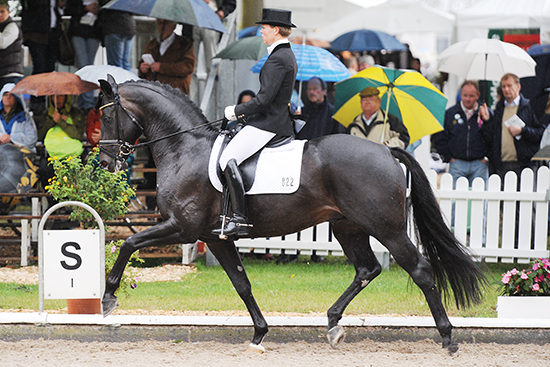 Second in the 5YO Championship in 2009 – Rosandro (Rosario / Sandro Hit) and Kira Wulferding
Second in the 5YO Championship in 2009 – Rosandro (Rosario / Sandro Hit) and Kira Wulferding
Looking at the top 18 in the 5 Year old dressage championships at the Bundeschampionate in 2009, we find four representatives of the ‘R’ line: one by Rosario (Rubinstein / Castro), one Rubin Royal (Rohdiamant / Grundstein), one Rohdiamant (Rubinstein / Inschallah), and one Rosentau (Rubinstein / Noble Roi xx).
There are three F’s: one by Florestan himself, one by Fürst Heinrich (Florestan / Weltmeyer), and one by Floresco (Florestan / Rosenkavalier).
The highest placed ‘F’ representative in the 5YO Championship in 2009 – Fürst Romancier (Fürst Heinrich / Romancier) and Ulf Moller
There are two representatives of the B line: the winner, Blickpunkt by Belissimo, who is by Beltain by Bolero, out of the famous foundation mare of Dr Schultz Stellenfleth, Gänseliesel, by Grande; there was also one finalist by Brentano II (also by Bolero and out of another of Dr Schultz’s Grande mares, Glocke). In the Six year old championship at the 2009 Bundeschampionate, of the 15 finalists, four were from the D line of Donnerhall: two by Denaro (De Niro / Volturno), one by Diamond Hit (by Don Schufro, out of the famed Loretta – mother of Sandro Hit amongst others – by Ramino) and one was by Depardieu (De Niro / Luciano).
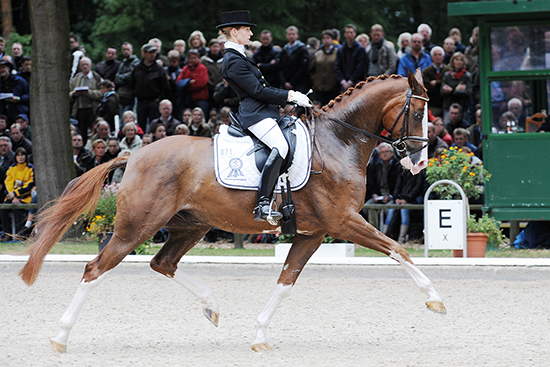 The undisputed winner in the 2009 5YO Championship – Blickpunkt by Belissimo out of a Weltmeyer mare, shown by Eva Moller
The undisputed winner in the 2009 5YO Championship – Blickpunkt by Belissimo out of a Weltmeyer mare, shown by Eva Moller
There were four representatives of the F line: First Love NRW by Florestan; Feine Dame and Florinero, both by Fürst Heinrich (Florestan / Donnerhall), and Fürst Kaspar by Fürst Piccolo, by the Florestan son, Fidermark.
Representing the ‘F’ line in the 2009 6YO final – Fürst Kaspar (Fürst Piccolo / Attraktiv) and Emma Kanerva
In a triumph for Wolfram Wittig’s breeding program, two sons of his stallion, Breitling, made the final. Wolfram bred Breitling and campaigned him up to Grand Prix level and since then he has been the sire of a string of successful dressage horses. Breitling is by Bismark who was by Bolero out of a Duellant mare.
Balmoral W (Breitling / Diego xx), a finalist in the 6YO Championship with Brigette Wittig
However the huge success and influence of the Bundeschampionate in itself has a worrying note in terms of the type of horse being bred – there are some who feel that its success is a threat to the long term future of the German Warmblood. As they see it, the concentration on young horse classes – particularly the three and four year old riding horse classes – produces a rich crop of showy youngsters who then never go on to compete in the ‘big sport’. Certainly that was the conclusion drawn by Dr Axel Brockmann in his doctoral study, Alternative Concepts for the Performance Test of Stallions under consideration of Competitions, where he found no positive correlation between success in the three and four year old classes and later success in higher-level competition.
However a look at the honor roll of winners at the Bundeschampionate does give lie to the assertion that Young Horse class winners NEVER go on to Grand Prix. It does seem that a fair proportion of the stars of the early Riding Horse classes were never heard of again but of more recent times, the winners have been more successful at higher levels. The mare Bini Bo (by Bolero) who won the 4 year old class in 1987 with Inge Schmezer, went to Grand Prix with Inge, Rohdiamant, a three year old winner in 1993, later competed Grand Prix, as did Welt Hit O who won the 4 year olds in 1995 with Bianca Kasselmann. Others to go Grand Prix: Fidermark (4 year old in 1996), Exupery (4 year old in 1997), Wahajama (4 year old in 1998) and Ronaldo (4 year old in 1999). And there were some fairly impressive stallions who took honours in the Riding Horse Classes: Wittinger, Davignon, Wolkenstein, French Kiss, Belissimo M and Londonderry.

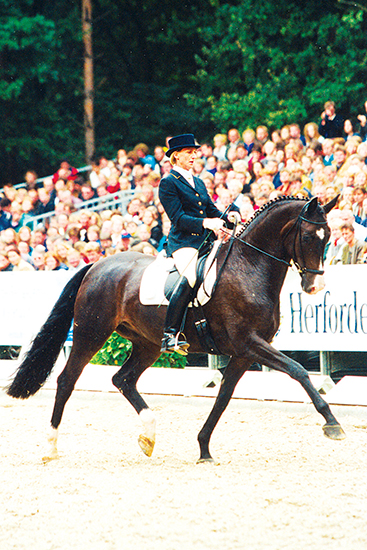
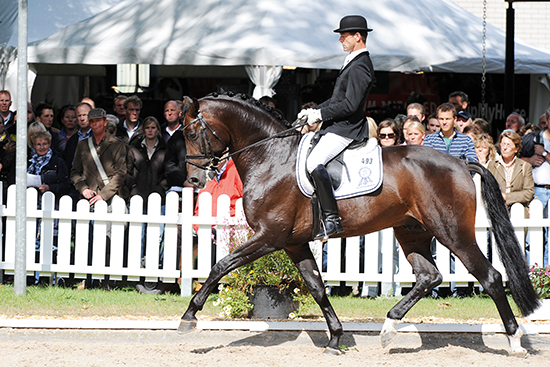
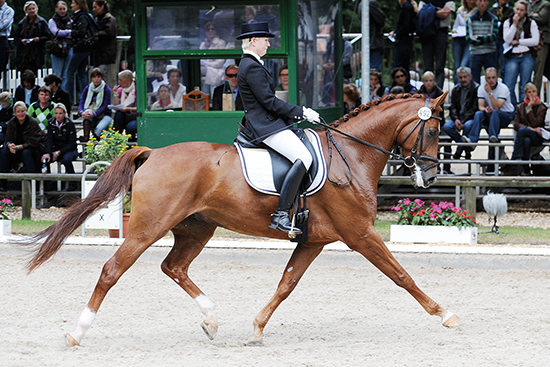
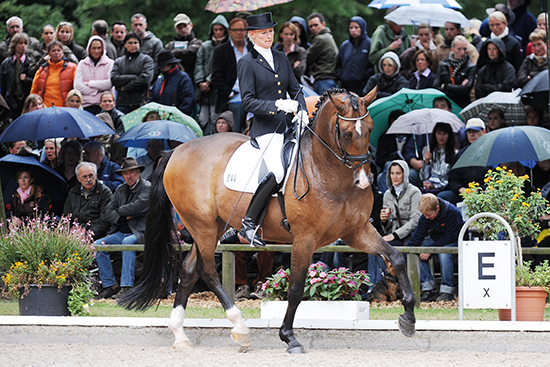
In dressage you are not supposed to crank your horses nose in. When a rider uses the correct aids the horse will round or collect voluntarily. Dressage judges aren’t stupid. even lower level ones. If you horse is not being supple on its own they WILL take points off. even it you are a beginner. You are not a true horseman rider if you do force the horses to be perfect.